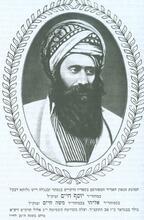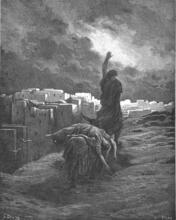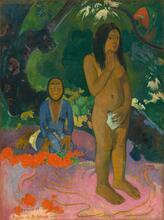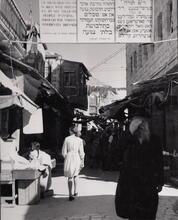Sotah
Required of women who are suspected of committing adultery, sotah is a ritual involving a priest to confirm whether the act occurred or not; a woman who has been unfaithful is made infertile. Most cultures in biblical times perceived adultery as an offense against the husband and so left punishment to him, but biblical law states that marital infidelity is a religious transgression. Subsequently, there are few records of sotah actually taking place, although the ritual is described at length in some post-Biblical literature. Modern scholarship pertaining to sotah often relates to its gender inequality, and the ritual has inspired artistic works, including a play.
The Ritual
Sotah (beginning in Lit. "teaching," "study," or "learning." A compilation of the commentary and discussions of the amora'im on the Mishnah. When not specified, "Talmud" refers to the Babylonian Talmud.Talmudic literature) is the term for a woman suspected of adultery, who must undergo an ordeal that will establish her guilt or innocence. Numbers 5:11–31 describes in detail the ritual, which a priest performs in the Tabernacle to determine whether a woman whose husband suspects her of adultery is indeed guilty. The Torah she-bi-khetav: Lit. "the written Torah." The Bible; the Pentateuch; Tanakh (the Pentateuch, Prophets and Hagiographia)Torah (Pentateuch) determines that a husband who suffers from “a spirit of jealousy” and suspects his wife must bring her to the priest at the Tabernacle. There the priest performs a series of ritual acts: he offers a “meal-offering of jealousy,” an offering of ground barley without oil or frankincense, unbinds the woman’s hair, makes her swear an oath that she had sexual relations with no man other than her husband, writes the oath in a scroll and erases it in water mixed with dust from the Tabernacle, and finally makes the woman drink the mixture.
This mixture, which the Torah calls “the bitter, curse-causing waters,” contains the oath and the curses that accompany it, and ultimately determines the woman’s fate. As the woman drinks the potion, the outcome of the trial appears on her body, confirming or refuting her husband’s suspicions: If she is guilty, the water will cause the woman to become infertile (the expressions “her thigh falls” and “her belly distends” are probably euphemisms for harm to the sexual organs), but if she is innocent the water will do her no harm and even cause her to become fertile.
Modern Analysis
The biblical ritual is structured as a divine ordeal, which was a customary way of resolving doubt in the ancient East. However, while the surrounding cultures used trial by ordeal for many areas, from murder to theft, in biblical law it exists only in the case of the sotah. This has led researchers to suggest various reasons for its uniqueness.
Jacob Milgrom, for example, believes that for this instance biblical law adopted a foreign pagan institution in order to save women from public lynching, which was the probable fate of a woman with a reputation as an adulteress. Others said that in a case of suspected adultery, as in murder (cf. Deut. 21:1–9), doubt is a usual occurrence, but at the same time it is perceived as dangerous and defiling, and thus must be resolved in metaphysical ways.
In general, the biblical status of adultery is different from that customary in the ancient East. Moshe Greenberg showed that while most cultures in biblical times perceived adultery as an offense against the husband and therefore left the punishment of the adulterers to him, in biblical law adultery is perceived, first and foremost, as a religious transgression that carries the death penalty (note that adultery in biblical as well as rabbinic literatures, is defined as sexual relations between a married woman and a man other than her husband. The paramour’s marital status is irrelevant to the case.) However, the near eastern traditions are echoed in a few places in the Prophets, where the adulteress’s punishment is given over to the community and sometimes even to her paramours. This includes public disrobing and humiliation and death at the hands of the community (see esp. Ezekiel 16:36–41; 23: 46–49).
Scriptural References
We have no accounts from biblical times about the performance of the ritual. The only existing accounts of the performing of the ritual are a few places in the Codification of basic Jewish Oral Law; edited and arranged by R. Judah ha-Nasi c. 200 C.E.Mishnah (Yoma 3:10; Eduyyot 5:6), but the Mishnah’s non-historical character does not allow us to derive solid historical accounts from it. Even if we accept that the ritual was performed, it is hard to know exactly what form it took.
Various descriptions of the Sotah ritual are preserved in pre-rabbinic compositions—Philo of Alexandria (De Spec. Leg. 3: 52–62), Josephus Flavius (Ant. 3: 270–273), and Qumran (4Q270.4)—and certain details in their descriptions are indeed different from biblical ones. It appears, however, that the changes come from interpretive traditions as well as ideological trends but contain no hint of actual familiarity with the ritual. Indeed, a Lit. (from Aramaic teni) "to hand down orally," "study," "teach." A scholar quoted in the Mishnah or of the Mishnaic era, i.e., during the first two centuries of the Common Era. In the chain of tradition, they were followed by the amora'im.Tannaitic tradition, given in the name of Rabbi Yohanan ben Zakkai, maintains that the ritual was discontinued because “adulterers proliferated.” (According to Mishnah Sotah 9:9, he was the one who discontinued it, but according to (Aramaic) A work containing a collection of tanna'itic beraitot, organized into a series of tractates each of which parallels a tractate of the Mishnah.Tosefta Sotah 14:1, he merely tells of its annulment, which occurred before his time).
An entire section in the Mishnah, Tractate Sotah, is devoted to the ritual. The ritual described in the Mishnah differs significantly from the scriptural version (much more so than the versions of Philo and Josephus). The Mishnaic ritual contains stages of abasing and humiliating the woman in public and ends with her death in the Temple. Indeed, some Tannaitic sources oppose these stages explicitly, claiming that: “It is not appropriate to degrade the Israelite daughters in a manner that exceeds what is written in the scripture” (Sifre, Numbers 11). The harsh ritual is softened somewhat in the Mishnah, in the assertion that a woman’s merits may postpone her punishment even for many years (“pending merit,” Mishnah Sotah 3: 4), and in the law that “As the water probes her [the alleged adulteress], it probes him [the adulterer] as well” (Mishnah Sotah 5:1).
Although the Sotah trial was probably discontinued (if it was ever indeed practiced) during the Second Temple era, its cultural presence continued due to the study of Tractate Sotah as part of the talmudic codex. With the growth of awareness of gender issues, the question of the representation of femininity and the tractate’s attitude to it has arisen in all its acuteness. The extreme character of the ritual and its essential inequality have led to different ways of coping with it, ranging from apologetics to severe criticism. It has also inspired various artistic treatments, such as the play Sotah, created and performed by the Jerusalem Theater Company (1999), and the journal Elu ve-Elu 4 (1997), a publication of the Elul Houses of study (of Torah)bet midrash in Jerusalem, dedicated entirely to examining Tractate Sotah from critical, feminist and modernist viewpoints.
Boyarin, Daniel. Women's bodies and the rise of the rabbis: the case of Sotah. na, 2000.
Frymer-Kensky, Tikva. "The strange case of the suspected Sotah (Numbers v 11-31)." Vetus Testamentum 34, no. Fasc. 1 (1984): 11-26.
Jeon, Jaeyoung. "Two laws in the Sotah passage (Num. v 11-31)." Vetus Testamentum 57, no. 2 (2007): 181-207.
Rosen-Zvi, Ishay. "Measure for measure as a hermeneutical tool in early rabbinic literature: The case of Tosefta Sotah." Journal of Jewish studies 57, no. 2 (2006): 269.
Rosen-Zvi, Ishay. The Mishnaic Sotah Ritual: Temple, Gender and Midrash. Vol. 160. Brill, 2012.







